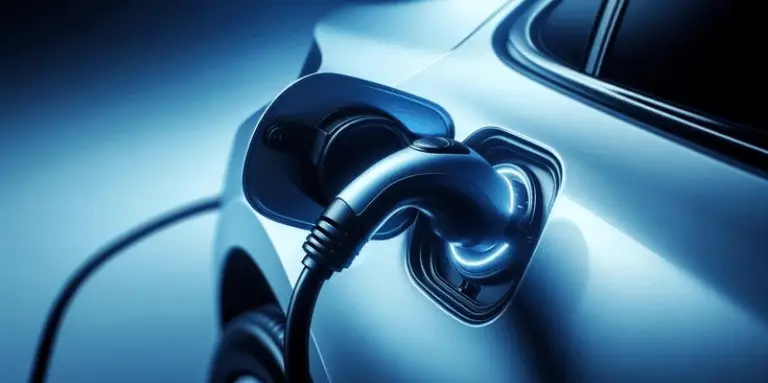Electric car sockets: everything you need to know for efficient recharging
Domestic sockets
- Standard domestic socket
The standard domestic socket for electric cars, also known as the mains socket, wall socket or power socket, is the most common electrical socket in the home, generally of the E/F type in France, recognisable by its two round pins. It can be used to recharge an electric car, but has major limitations in terms of speed and safety, with charging power limited to a maximum of 2.3 kW single-phase 10 A, far lower than dedicated charging solutions such as wall-mounted charging points (wallbox) delivering up to 22 kW or more.
Recharging an electric car completely from a household socket can take several hours, or even a whole night, depending on the capacity of the car. battery of the vehicle. In addition, regular use of a domestic socket to recharge an electric car is not recommended, as it is not designed for this purpose and may present risks of overheating or electrical overload.
- Reinforced socket (Green'Up)
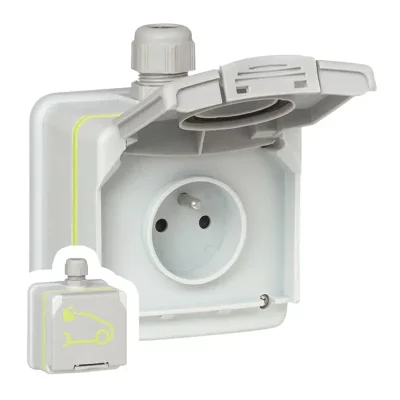
The Green'Up reinforced socket, designed specifically for recharging electric and plug-in hybrid vehicles, offers several advantages over a standard domestic socket. With a recharging power of up to 3.7 kW in single-phase alternating current, it can recharge up to 60 % faster than a standard 2.3 kW domestic socket. Equipped with enhanced safety systems such as an IP66 dust and water splash protection flap, shutters to prevent the insertion of foreign objects, a temperature control device to limit the risk of overheating, and earth fault detection, it guarantees safe and reliable recharging.
Its improved ergonomics make it easier to connect and disconnect the charging cable, while an LED charge indicator provides information on the current charging status. Compatible with most electric and rechargeable hybrid vehicles on the market, the Green'Up plug requires installation by a qualified electrician, with a dedicated circuit and its own circuit-breaker protection.
Although more expensive than a standard household socket, it is still cheaper than a wallbox, offering faster, safer recharging and simple, intuitive operation, with a modern, aesthetic design.
Slow charging sockets
- Type 1 socket
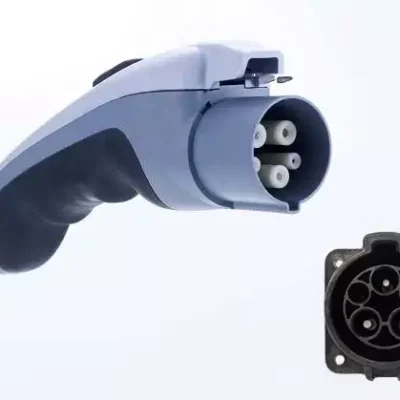
The Type 1 plug, also known as SAE J1772 or Yazaki, is a standard charging connector for electric vehicles, with five pins for communication between the car and the charging point. It uses single-phase alternating current, offering a maximum recharging power of 7.4 kW, corresponding to slow or semi-accelerated recharging.
The Type 1 plug is mainly used in Asia and the United States, with applications including home plug charging (although not recommended for safety reasons), public charging points, and mobile cords for on-the-go charging. It is compatible with models such as the Citroën C Zero, Ford Focus Electric, Kia Soul EV, Mitsubishi iMiev, first-generation Nissan Leaf, Nissan e-NV200, Opel Ampera and Peugeot iOn.
In Europe, the Type 2 plug has become the dominant standard for faster recharging, but adapters are available to connect a car fitted with a Type 1 plug to a Type 2 charging point.
- Type 2 socket
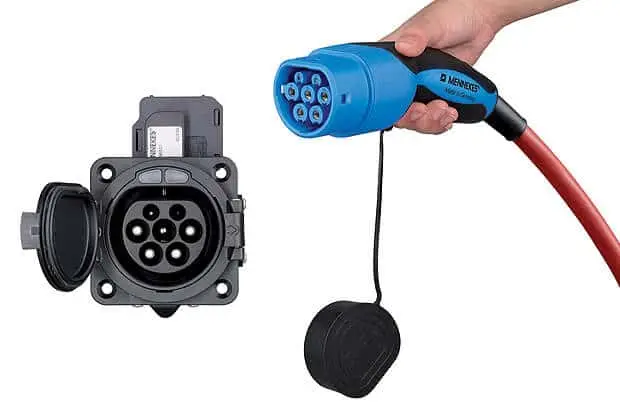
The Type 2 socket, also known as the Mennekes socket, is the European standard for recharging electric vehicles. alternating current (AC) and direct current (DC). It offers great versatility, allowing single- or three-phase AC charging with power from 3 to 43 kW, as well as DC charging for fast charging up to 170 kW (CCS standard).
Used for home recharging on wallboxes, public charging points and rapid recharging on dedicated charging points, the Type 2 socket is ubiquitous in Europe and equips the majority of modern electric vehicles.
It is compatible with a wide range of models, including Audi e-tron, Dacia Spring Electric, Fiat 500e, Renault Zoe, Megane E-Tech, Tesla Model 3 and Model Y and others.
The Type 2 plug comes in two versions: a female plug on the charging point and a male plug on the car's cable, and the charging speed depends on the power of the charging point and the vehicle's charging capacity.
Fast charging sockets
- Socket CHAdeMO
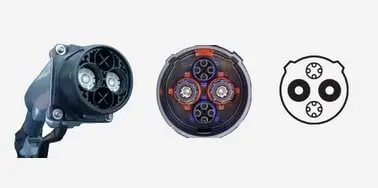
CHAdeMO, short for "CHArge de MOve", is a Japanese fast-charging standard for electric vehicles, featuring a large oval connector for high current transmission in direct current (DC) with a maximum power of up to 400 kW for very fast charging.
Unlike Type 2 plugs, where the cable is detachable, the charging cable is attached directly to the terminal. This standard is used in charging stations dedicated fast-charging stations, motorway service stations and shopping centre car parks. Mainly used in Asia and on certain models in the United States, CHAdeMO charging is faster than alternating current (AC) charging, but also more expensive, and competes with the CCS standard in Europe.
- CCS (Combined Charging System) socket
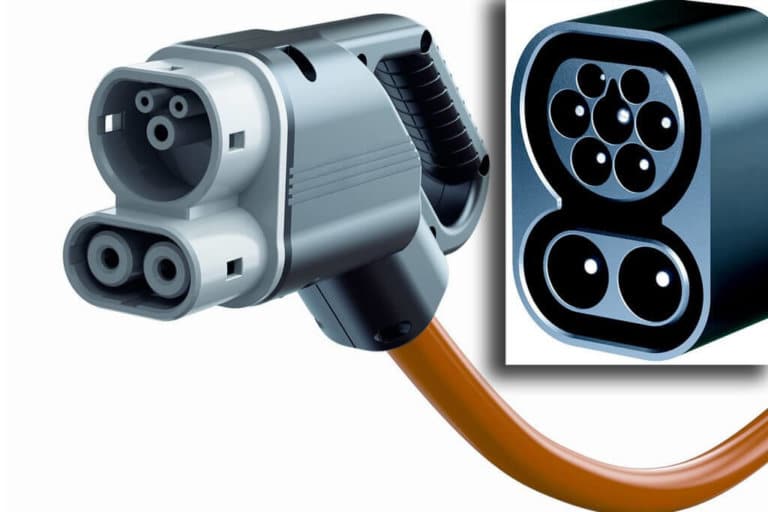
The CCS, or Combined Charging System, plug represents a combined charging standard for electric vehicles, the result of collaboration between European and American manufacturers, offering drivers great flexibility by enabling both alternating current (AC) and direct current (DC) charging. Its combined connector combines the Type 2 plug for AC with two additional pins dedicated to rapid DC charging. It enables AC charging of up to 43 kW, similar to the Type 2 plug, and ultra-fast DC charging of up to 350 kW, depending on the version.
The CCS plug is used at public AC and DC charging points, motorway service stations and rest areas equipped with fast charging points. It has become the dominant standard in Europe, equipping the majority of modern electric vehicles sold on the continent.
Charging speed depends on the power of the charging point and the vehicle's charging capacity, and although it competes with the CHAdeMO standard for fast charging, the CCS plug is becoming the predominant standard in Europe.
- Tesla Supercharger socket
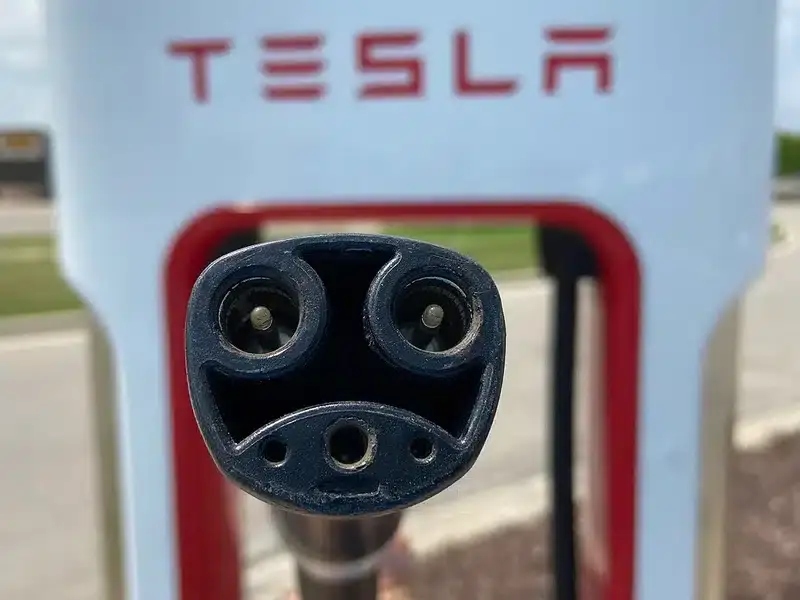
The Tesla Supercharger plug is an exclusive connector developed by Tesla for fast charging of its electric vehicles. It features a unique connector that is incompatible with other charging standards, and allows ultra-fast direct current (DC) charging of up to 250 kW, enabling a Tesla battery to be recharged in around twenty minutes. Equipped with a liquid cooling system to manage high power levels and optimise charging speed, the Supercharger network is reserved exclusively for Tesla vehicles. Tesla.
It's simple to operate: just plug the Tesla connector into the vehicle to start charging automatically, with payment made via the driver's Tesla account. Tesla's navigation system makes it easy to locate Superchargers and monitor charging status. Its benefits include extremely fast charging, ideal for long journeys, expanding network coverage along motorways, and much-appreciated reliability and ergonomics.
However, the Supercharger does have its drawbacks, such as its exclusivity to Tesla vehicles, a higher cost of charging than conventional public stations, and the potential for large crowds at stations, especially at peak times. It is only compatible with Tesla vehicles, while Tesla also offers slower home charging stations called Wall Connectors.
To find out more, click here: Everything you need to know about Tesla's charging station
Ultra-fast charging sockets
- CCS Combo 2 socket
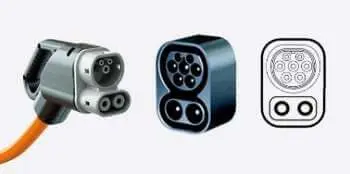
The CCS Combo 2 socket, also known as the Combined Charging System, is a versatile charging standard for electric vehicles that is becoming the norm in Europe. It combines a Type 2 socket for AC charging with two additional pins for fast DC charging. Offering AC charging of up to 43 kW for everyday use and ultra-fast DC charging of up to 350 kW for long journeys, the CCS Combo 2 plug is fitted to the majority of modern electric vehicles sold on the continent.
It is used on public charging points AC and DC, at motorway service stations and rest areas equipped with fast-charging stations. Recharging speed depends on the power of the terminal and the capacity of the vehicle. Although it competes with the CHAdeMO standard for fast charging, the CCS Combo 2 socket is becoming the predominant choice in Europe, offering fast, versatile charging for a variety of needs, with growing compatibility with new electric vehicle models and an expanding network of charging points.
However, it can be more expensive than AC charging and requires a compatible charging point to take advantage of fast charging.
How do you choose the best charging point for your electric car?
To choose the best charging socket for your electric car, a number of factors need to be taken into account. First of all, the type of electric vehicle you drive is important: Tesla vehicles require the exclusive use of Tesla Supercharger plugs, while other vehicles need to be compatible with charging standards such as CCS Combo 2, CHAdeMO for fast charging, or the Type 2 plug for the slower AC charging commonly used in Europe.
Secondly, your recharging needs play a decisive role: if you recharge your vehicle daily at home or at work, a Type 2 socket is often sufficient. On the other hand, for regular long-distance journeys, opting for a fast or ultra-fast recharging socket such as CCS Combo 2 or CHAdeMO will cut recharging times considerably.
Budget is another factor to consider: AC charging sockets are generally less expensive than fast or ultra-fast charging sockets, which offer faster charging but at a higher cost.
Finally, the availability of charging stations is essential: Type 2 stations are the most widespread in Europe, offering extensive coverage of the network. CCS Combo 2 and CHAdeMO charging stations, although increasingly numerous, are still less common than Type 2 stations, but their deployment is intensifying to meet the growing demand for fast and ultra-fast charging.
Read more: Everything you need to know about recharging electric cars: complete guide to 2024 recharging points
Conclusion
In conclusion, choosing the best charging socket for your electric car depends on a number of factors, such as the type of vehicle, your charging needs, your budget and the availability of charging stations. Tesla Supercharger plugs are a must for Tesla vehicles, while CCS Combo 2 and CHAdeMO plugs offer fast-charging solutions for a variety of electric vehicle models, with a growing preference for CCS Combo 2 in Europe.
For everyday charging, a Type 2 socket is generally sufficient and more economical, while fast-charging stations such as CCS Combo 2 and CHAdeMO are essential for long journeys.
If you're planning a home or business installation, don't hesitate to call on Beev for a professional service tailored to your needs.
If you would like to find out more about the tax credit for in-car charging points 2024For more information, see our article on this subject.
